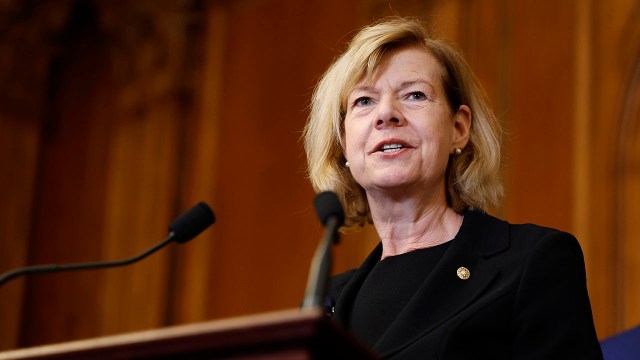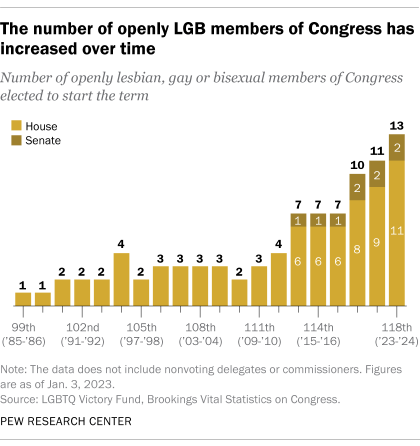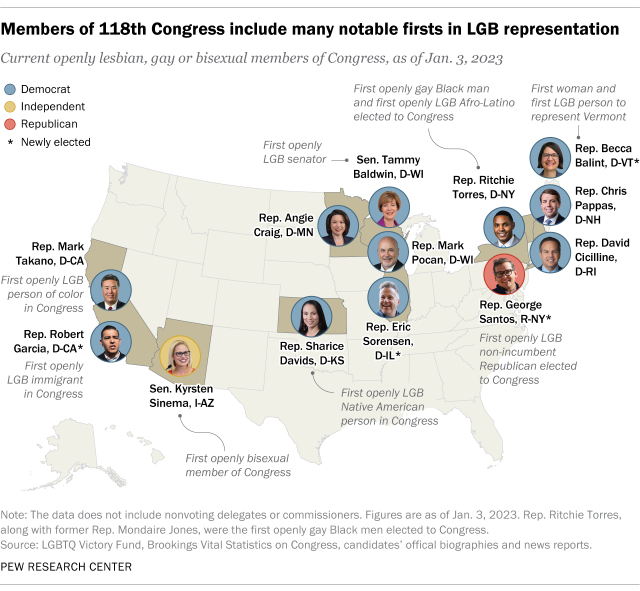
Thirteen voting members of the 118th Congress identify as lesbian, gay or bisexual – the highest number of openly LGB members in history. While small, the number of LGB lawmakers in Congress has steadily increased over the last decade.

Two senators and 11 members of the House of Representatives identify as lesbian, gay or bisexual, according to a Pew Research Center analysis of lawmakers’ official biographies, campaign websites and news reports. The previous Congress included a total of 11 LGB lawmakers.
The number of LGB members of Congress has more than tripled in recent years. In the 112th Congress of 2011-13, just four members – all representatives – identified as gay or lesbian (and none as bisexual), according to data from the Victory Fund, a political action committee that works to elect LGBTQ politicians.
In the current Senate, Democrat Tammy Baldwin of Wisconsin became the first openly LGB person to serve in the chamber when she was elected in 2012, and Kyrsten Sinema, an independent from Arizona, is the first openly bisexual person to serve in either chamber.
How we did this
This analysis is part of Pew Research Center’s work to analyze the demographic makeup of the U.S. Congress. To determine the number of LGBTQ lawmakers in the 118th Congress, we used data from the LGBTQ Victory Fund, a political action committee that works to elect LGBTQ politicians; Brookings Vital Statistics on Congress; and our own analysis of official biographies, campaign websites and news articles. Data on the share of Americans who are gay, lesbian or bisexual comes from Gallup.
Freshman lawmakers include all members of Congress who were elected for the first time in a regular election in the 2022 midterm cycle.
Our analysis reflects the 534 voting members of Congress as of Jan. 3, 2023, not including one vacant seat in the House following the death of Democratic Virginia Rep. Donald McEachin.
This analysis of LGBTQ representation of U.S. senators and representatives is limited to the gender and sexual identities that have been openly represented in the U.S. Congress. As of the 118th Congress, this includes lesbian, gay and bisexual members.
In the House, all but one of the 11 openly gay or lesbian representatives are Democrats. The exception is Republican George Santos of New York, who in the 2022 midterm cycle became the first openly gay, non-incumbent Republican to win a congressional election. (Since then, however, key aspects of Santos’ biography have been called into question.)

Seven of the 11 openly gay or lesbian representatives in the House are returning members of Congress. The four newly elected members include Santos; Robert Garcia, D-Calif., the first openly gay immigrant elected to Congress; Democrat Eric Sorensen, the first out gay congressperson to represent Illinois; and Democrat Becca Balint, the first woman and first openly LGB person to represent Vermont.
Eight of the 11 House members who identify as gay or lesbian are gay men and three are lesbians.
Despite the steady increase in LGB representation on Capitol Hill, this group remains underrepresented compared with the U.S. population as a whole. The 13 LGB members of Congress account for about 2% of the 534 voting lawmakers as of Jan. 3, 2023. LGB Americans make up 6.5% of the adult population overall, according to a 2021 Gallup survey.
The record congressional diversity in sexual orientation comes alongside several other milestones in LGBTQ political leadership in the United States. In the November midterm elections, Maura Healey of Massachusetts and Tina Kotek of Oregon became the first openly lesbian governors in U.S. history. And several state legislatures now include transgender or nonbinary lawmakers for the first time, including New Hampshire, which became the first state in the country to elect a transgender man to its state legislature.








